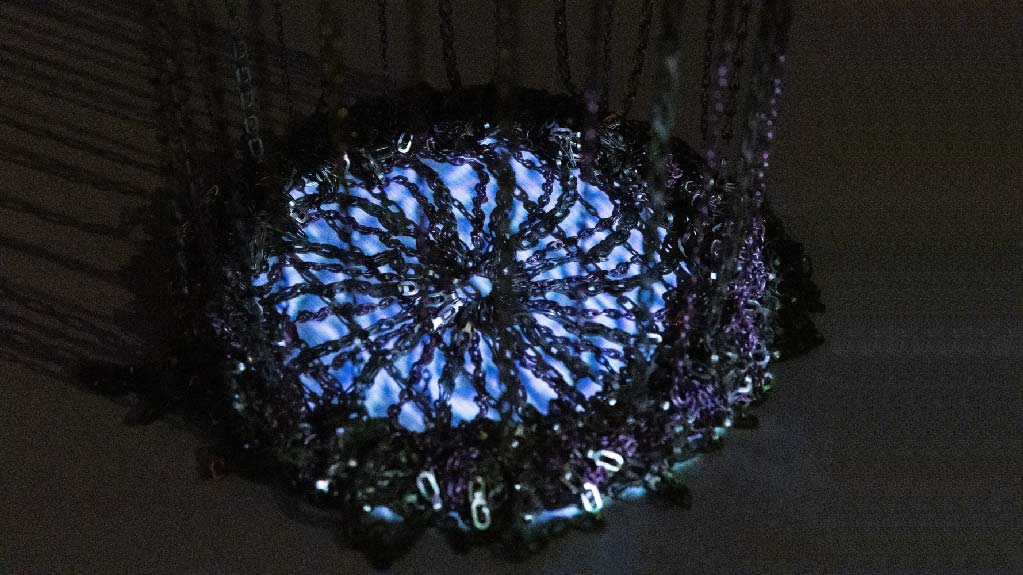Paramo
Andres Franco
Advisor: Simone Salvo
This sculpture represents a Frailejón—a plant that plays a vital role in collecting water from the air and releasing it into the Páramo, an ecosystem that supplies water to Bogotá.
Use your physical strength to raise this sculpture. As you do, you’ll collect, create, and give—just as the Frailejón does—while experiencing it through your senses: touch, sight, hearing, and smell.

Project Description
Where does the water that your city consumes come from? For Bogotá, my city, the water comes from the Páramo. The Páramo is a high-altitude ecosystem where its vegetation acts as a natural "sponge," collecting water from the air and rainfall, and releasing it slowly over time. This beautiful ecosystem and landscape can be found in the tropical regions of the Andes, and only six countries in the world have it. Among them, Colombia possesses 60% of the Páramos. Its most iconic plant is the Frailejón, which can grow up to 10 feet tall. Its hairy leaves and thick, spongy trunk trap humidity from the fog, forming small drops that gradually drip and flood the Páramo's soil.
I honor this plant and its ecosystem through a hanging kinetic sculpture that represents, in an abstract way, a Frailejón. To achieve this, I used materials and a color palette that evoke the earth, soil, and organic forms. The materials include copper and brass chains, cherry wood, dry bushes, copper-colored ribbons, fique rope, and pulleys—some of which are salvaged materials.
This hanging sculpture starts collapsed on the floor. To reveal its full form, participants must use their physical strength to pull a rope connected to a pulley system, lifting the "Frailejón." As it rises, gravity subtly expands the chains, creating a tall, organic sculpture. When participants release the rope, the chains form a random organic shape on the floor. Additionally, digital elements are integrated through projection mapping, displaying a puddle on the floor and simulating waves as drops of water drip.
This pulling interaction encourages participants to feel as though they are collecting, holding, creating, and giving, much like the Frailejón does in the Páramo. It also engages their senses—touch, sight, hearing, and even smell—offering an experience that brings them into the moment.

Technical Details
For the kinetic sculpture, I used materials and a color palette that evoke earth, soil, and organic forms. These materials include copper and brass chains, cherry wood, small copper and brass hooks, dry bushes, copper-colored ribbons, fique rope, and pulleys—some of which are salvaged.
The sculpture is lifted by participants using physical force to pull a fique rope that runs through a two-pulley system attached to the ceiling grid. As it rises, gravity causes the copper and brass chains—previously collapsed on the floor—to reshape into an organic form.
A digital element is integrated through projection mapping, displaying a video of a puddle on the floor and simulating ripples as drops of water fall. To map the video into a circular shape, I used MadMapper software, with a projector mounted to the ceiling grid using a magic arm.
In addition to the physical interaction, an electronic input also modifies the video output. A magnet attached to the rope triggers a Hall effect sensor located on one of the pulleys. An Arduino Nano 33 IoT receives this signal and sends a message over Wi-Fi using the OSC (Open Sound Control) protocol. A laptop receives these messages and uses them to alter the projected water video accordingly.
.1.jpg)
Research/Context
This project draws from a broad range of artistic and conceptual influences. I was inspired by kinetic sculptors like Nik Ramage, Reuben Margolin, and Daniel Rozin, whose works explore motion, perception, and physical interaction. The immersive and sensory approach of Anicka Yi and the narrative magic of Skullmapping also informed my approach. From music, Jorge Drexler’s song Movimiento reinforced ideas around transformation, identity, and natural cycles.
Technically and conceptually, this sculpture continues the themes I explored in previous works such as Infinity Heart, Positive Energy, and Three Minutes—especially the use of salvaged materials, body-powered interaction, and organic movement. I sourced materials from Materials for the Arts (Long Island City) and Big ReUse (Gowanus), letting the available components guide form and scale.
Instead of motors or electricity, I chose human energy and gravity as the primary drivers of the sculpture's movement, reflecting my ongoing interest in alternative energy sources and creating physical experiences that involve time, effort, and intention. The choice of materials—such as copper and brass chains, dry plants, and natural fiber rope—was not only aesthetic but symbolic, reinforcing the tactile, grounded qualities of the Frailejón and its ecosystem.


